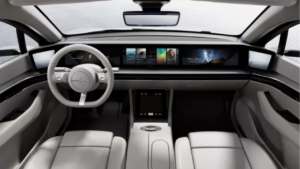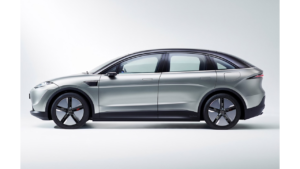The car industry has faced several changes in the past decade. All car companies are now evolving to a new age of electric cars. This means cleaner cars that can hit 0-100 Km/H in no seconds and a developing self-driving advanced technology that will change how we travel, right?
New technologies are making car manufacturers transform into tech companies, and tech companies are noticing it. This is changing the traditional car business models. Automobile companies now compete with tech giants like Samsung and Sony, and even Apple is rumored to enter the industry. New business models that include Big data and software development are going to be at the core of all major car companies, and this implies that just like your phone spy on every movement you make, your car is going to do the same to you and your surroundings all in the name of safety and better mobility.
TECH COMPANIES ARE STEPPING INTO THE CAR GAME
New players like Sony are stepping into the game. In CES 2020, Sony unveiled a new concept car.

This is proof that the Automobile industry is shifting. With the adoption of electric motors, cars are more accessible than ever (even though this is still an extremely complicated and expensive process), and tech companies see an opportunity to step into the game. This is still a concept, and Sony did not indicate that it had any plans to sell the car to the public. It seems to be more of a show of what is possible to do on modern cars using sony technology.

Sony has sold car appliances for several decades now. You probably have seen a car that had a Sony aftermarket radio or that is equipped with sony speakers. That is no news, but what is essential is the new technology that is being introduced. For example, the Sony Vision S has 33 robust image sensors that can be used to analyze the road in front of a vehicle. This showcases the company’s interest in the future of mobility, self-driving systems, and data collection technologies.
The story doesn’t end here. In 2022 Sony launched a new concept car, the Vision S02. This time sony envisions an SUV vehicle. They go as far as showing the vehicle’s specifications on their own website seems like a bold move to Sony. Why would a tech company invest so much in research and development on products that will never see production?

In my opinion, Sony is testing the waters in the Automobile industry, and I think it is likely that we might see a Sony car shortly. Sony knows that car companies will become more like software companies, and they don’t want to miss the boat in the industry’s changes soon. Only time can tell.
This is not the only example of a tech company trying to enter the Automobile industry. Apple has been working on a car project for a while. Rumors say that Apple is working on a fully autonomous self-driving vehicle that will not require user intervention to drive. It’s a highly ambitious project, and rumors indicate that Apple wants to design a car with no steering wheel or pedals. Nobody but a few Apple executives know how the project is going and when it will be unveiled. Apple has no experience with car manufacturing, and manufacturing cars is a complicated process that requires a lot of investment and a lot of expertise. For example, Tesla, a company that just focuses on cars, has struggled in the past with car manufacturing, facing quality issues and extensive delays. Apple will certainly need partners to produce the vehicle. It is not yet known who Apple will work with, but it has held discussions with Hyundai.
The point is that there is considerable interest in the tech industry to step into the car business, an industry that is highly risky and competitive requires lots of resources, and has lots of well-established players that have the brand recognition, know-how, and resources to crush the new competition. Why is this industry of such interest to these companies that have nothing to do with car manufacturing or mobility?
HIGH-TECH CARS FOR A SCI-FI FUTURE
Well, the future looks promising. The car industry is facing some hardcore innovation period that it has never faced before. You can argue that cars have become safer, faster, cleaner, and more efficient since the first cars were introduced more than a hundred years ago. Sure there have been a lot of innovations. Still, it has been pretty much to improve the original concept of a transportation vehicle that you have to drive with a steering wheel and obtains power from a combustion engine that lays in the ground with four rubber wheels.
Currently, virtually all car companies are moving into a future full of electric cars filled with high-tech gizmos and gadgets. In 2004, only a quarter of cars had airbags, and less than 50% had factory-installed power seats. However, this has changed drastically due to government regulation and customer demand, and adopting safety-related electronics systems has exploded.
Most of the automotive innovations today arise from electronics rather than mechanics. In 2007, around 20% of a car’s total cost came from electronics. In 2017, it increased to 40%, and this trend doesn’t seem to change anytime soon. As companies improve self-driving technologies, car sensors will have to increase. As time passes and economies of scale do their magic, these features will not be limited to high-end luxury cars but to cheap econoboxes. According to Deloitte, the demand for semiconductors used for infotainment systems, advanced driver-assistance systems, and fuel efficiency will increase for years due to ever-more electronic components being applied in advanced safety features added to vehicles.

This all looks awesome. High-tech advancements are making roads safer and are decreasing the chance of getting injured while on the road. But the devil is in the details.
SELF DRIVING TECHNOLOGY
Self-driving cars are closer than ever before, or at least that has been the promise for several years. Making cars drive is an extremely hard task, maybe the hardest for our generation. You must teach a car how to see and behave in different circumstances. You have to give them the power to make decisions that can determine if someone lives or dies. For a lot of humans, learning to drive is tricky. Making a computer learn to do so is more challenging.
With the recent advancements in the development of Artificial intelligence (AI), companies have been able to deliver systems that assist drivers. Still, a human has to be aware of the surroundings, and these systems cannot completely drive without assistance, but soon this won’t be necessary, and driving will be a chore of the past or an expensive hobby. And when I say near future, I mean NEAR future. Companies like Waymo, Cruise, TuSimple, and Aurora are already testing cars across the United States that don’t need a human driver.
SAE International (Society of Automotive Engineers) has defined five levels of car automation. It goes from level 0, which means that there is no assistance or technological help, to level 5, which means that the car can go around without human assistance or preloaded maps. It can just go to a new environment and go whether it needs to, just like a human being. Level 3 is where this technology gets interesting because, at this level, cars don’t need a driver in most conditions. At level 4, human driving won’t be necessary at all, and when we reach this level, you will see driverless taxis and semi-trucks on the roads.

The teaching process of AI technology is fascinating, the process requires data, and I mean tons of data. and the more data you gather, the better. Data is like the future of oil; you can build several multibillion-dollar companies just with Data.
An excellent example of a company already developing a product explains why big tech is stepping into the car business. Waymo is a company that started as a Google project in 2009 and already offers a driverless taxi service in California, U.S.A.
Its cars claim to have ridden more than 20 million driverless miles, which means that the A. I have gathered tons of images and driving scenarios from the area. It has a highly detailed map of the area down to a centimeter. All this data has taught the cars to drive themselves better and better.
So what, what’s the deal?
Well, the deal is that gathering all this data means gathering your data. The cars can collect data on the license plates of other cars. With a data set like that, you can classify other car drivers as good or bad, AI allows facial recognition, so if a Waymo car sees you, it can tell who you are, where you are, and when with whom we shouldn’t forget that this is a company owned by Google and is expected that they will add all of this information to its servers to know even more about you. The privacy concerns are not only for the people outside the car but also for the people inside it. Companies like Tesla, with its level 2 automation driving, are already gathering data on the people that drive their cars, from facial expressions to driving habits to real-time location, all of that is gathered in Tesla servers all the time.
You have to take into consideration that the auto industry is going to change drastically in the years to come. With self-driving technology, the car as a consumer product might change to the car as a service model. Nobody knows for sure what this means. Maybe we will see a pool of self-driving cars that you can get for a subscription fee that transport you whenever you want and that transport other subscribers when you are not using it, something like a Waymo subscription, and this has lots of benefits, from environmental reasons to lower cost for the user, among other things but we all should worry about the data that is being collected, and what are the companies that own the data doing with it
The data race in the car industry is just beginning, and big tech companies are noticing this is a race for data rather than cars. This will impact the future of mobility in ways we cannot even start to imagine.


